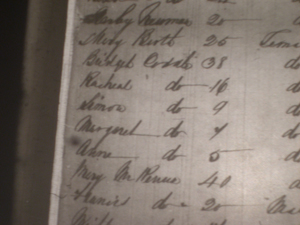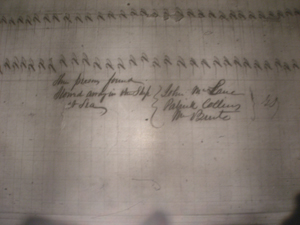A few years ago we felt pretty proud of ourselves when we found the graves of Elsa's great-great
grandparents, Patrick and Bridget Cadwell, in the St. James cemetery in Cazenovia, New York.
We know of 291 bonafide descendants of Patrick and Bridget, and they were all interested in the story
of these immigrant ancestors who came to the U.S. during the Irish Potato Famine, worked on the Erie
Canal, and bought a ten acre farm -- no doubt for a milk cow, some chickens, and plenty of firewood for
the cold New York winters. Thirty years after arriving in the United States, Patrick became a
naturalized citizen of the United States, and his surviving children were all educated persons - two
had even worked as schoolteachers.
"But what about that old wood boat?" Patrick and Bridget's descendants asked us. The story had
been remembered by a number of other great-grandchildren, telling how the couple with five children
had gotten aboard a boat and crossed the Atlantic in seven cruel weeks, "seven souls on an old wooden boat."
One of the children, so the story went, had died on board and was buried at sea. Some versions added
that Bridget, before emigrating, had worked as a maid for Queen Victoria. We had alternated between
believing the stories in toto to doubting some or most of the details.
Our problem had to do with finding ship passenger lists. The majority of ships arriving in
America from Europe at that time did leave reasonably accurate passenger manifests with the port
officials where the ships docked, and the majority of those manifests have been turned over to NARA,
the National Archives and Records Administration, and been microfilmed.
But without knowing the name of the ship or at least the date of arrival, searching the
passenger lists has been a daunting task -- definitely like looking for a needle in a haystack.
However, genealogists have been volunteering to transcribe and index
ship passenger lists, so we have kept looking for the family on the online indexes,
hoping to get lucky. We were doing a search for "Simon C----" (Simon was one of Patrick and Bridget's
children) and found an entry for Simon Codale on the ship Caroline Nesmith. Could this be Elsa's
great-grandfather? Unfortunately, for some reason the image of the microfilmed ship's manifest was
not yet available on the internet, so we decided it would be nice to go the NARA regional center
on Varick Street, New York City.
Here's part of the manifest microfilm. From the header we learned that the Caroline Nesmith
 Caroline Nesmith manifest
had arrived in New York from Liverpool on
29 July 1848. Her day of departure
was not given on the passenger manifest, so we couldn't decide if the crossing actually
took seven weeks. The master was James Eaton, and approximately 300 passengers were
listed. After carefully examining the manifest, we found that the last name
as written was actually Coddle, not Codale --
the upward stroke on the second "d" was short and the indexer mistook it for an "a" .
Caroline Nesmith manifest
had arrived in New York from Liverpool on
29 July 1848. Her day of departure
was not given on the passenger manifest, so we couldn't decide if the crossing actually
took seven weeks. The master was James Eaton, and approximately 300 passengers were
listed. After carefully examining the manifest, we found that the last name
as written was actually Coddle, not Codale --
the upward stroke on the second "d" was short and the indexer mistook it for an "a" .
The manifest was rather sloppily prepared, and all five of the following persons had a "do" (for ditto)
indicating female sex! After looking at passenger listings on other pages as well,
we have decided that gender and occupations should be ignored.
 The Cadwell/Codale party
Bridget Coddle, 38, Servant
The Cadwell/Codale party
Bridget Coddle, 38, Servant
Racheal ", 16, do
Simon ", 9, Dress Maker
Margaret ", 7, do
Anne ", 5, Servant
Using the information from our database, these names and ages should have been
Bridget Cadwell, 37
Richard, 11
Simon, 9
Margaret, 4
Ann, 5
The surname Coddle did not surprise us. We have seen a deed and mortgages executed in 1858 in New York
State which used the spelling Caddle. Remembering that Patrick was illiterate, this would indicate the way
in which he pronounced his name. In the 1850 census, he was listed as Patrick Cadle. But on the 1860 census,
his name was spelled Patrick Cadwell.
The ship manifest information did not list the son James, who earlier family historians had told us was
stricken and buried at sea. The family monument in St. James' Cemetery, Cazenovia, New York, erected
after Bridget's death in 1884, says James died Feb, 1852, age 1 year 6 months, a native of Ireland, which
doesn't make sense. We will have to seek information in the Family Records Centre in London for the death of
James at sea, which should have been reported by the Master of the ship on his return to England.
But where was Patrick on this manifest? Well, there was no Patrick Coddle listed. We looked through all the
pages, and found the following persons named Patrick:
Patrick Maher, age 11, Mason
Patrick Casey, 18, Brasier
Patrick Fitzgerald, 8, Labourer
Patrick Ryan, 4, Labourer
Patrick Mullen, 30, Labourer
Patrick Donovan, 24, School Child
Patrick Moore, 21, Tailor
Patrick McMahon, Infant
Patrick O'Neil, 5, Servant
and on Page 1 the following note added sideways:
|
|
| These persons found |
|
} |
|
|
John McLane |
| Stowed away in the Ship |
|
} |
|
|
Patrick Collins |
| at Sea |
|
} |
|
|
Wm Bunte |
So there are, it seems, four possibilities:
1. Patrick was not on the ship with the rest of his family.
2. Patrick was on the ship but mistakenly not shown on the passenger manifest.
3. Patrick was on the ship but mistakenly given a totally different last name and age.
4. Patrick was on the ship as a stowaway and gave the name Patrick Collins, or even gave his
correct name which was incorrectly recorded as Patrick Collins.
Possibility 1 disagrees with the family story, and would only make sense if Patrick had come over first and
earned passage for the rest of the family, but there is no other evidence known to us in support of this theory,
and a strong part of the story is the "seven souls."
Possibility 2 is not likely as the passenger manifest was routinely used by U.S. authorities to account
for all passengers arriving in the U.S.
 The stowaways identified
The stowaways identified
Possibility 3 doesn't make much sense, as there would be no reason to change the name, unless it was a
grievous error on the part of the ship's clerk.
Possibility 4 is left as the most likely interpretation. The family was in extremis, fleeing the potato
famine. Only a slight miscalculation would have left the family short of funds to pay for passage from
Dublin to Liverpool and then to New York, as well as necessary food to enable them to survive the trip
(and of course James did not). If one of the family were to stow away, it would be Patrick who would take the risk.
Stowaways were sometimes tarred and feathered and made to work their passage; or perhaps they were indentured upon
arrival in the U.S. in order to repay the fare.
We shall probably never learn the full story, but at least now we know the name of the ship and the date of passage.
We don't know when the Caroline Nesmith was built, but we do know that she made a number of voyages carrying Irish
immigrants to America.
We discovered on the internet that the Caroline Nesmith now resides on a reef off Key Largo, Florida. She was
sunk on October 23, 1865 with 2500 bales of cotton on board.
 Caroline Nesmith manifest
had arrived in New York from Liverpool on
29 July 1848. Her day of departure
was not given on the passenger manifest, so we couldn't decide if the crossing actually
took seven weeks. The master was James Eaton, and approximately 300 passengers were
listed. After carefully examining the manifest, we found that the last name
as written was actually Coddle, not Codale --
the upward stroke on the second "d" was short and the indexer mistook it for an "a" .
Caroline Nesmith manifest
had arrived in New York from Liverpool on
29 July 1848. Her day of departure
was not given on the passenger manifest, so we couldn't decide if the crossing actually
took seven weeks. The master was James Eaton, and approximately 300 passengers were
listed. After carefully examining the manifest, we found that the last name
as written was actually Coddle, not Codale --
the upward stroke on the second "d" was short and the indexer mistook it for an "a" .
 The Cadwell/Codale party
The Cadwell/Codale party The stowaways identified
The stowaways identified